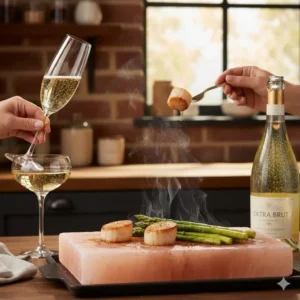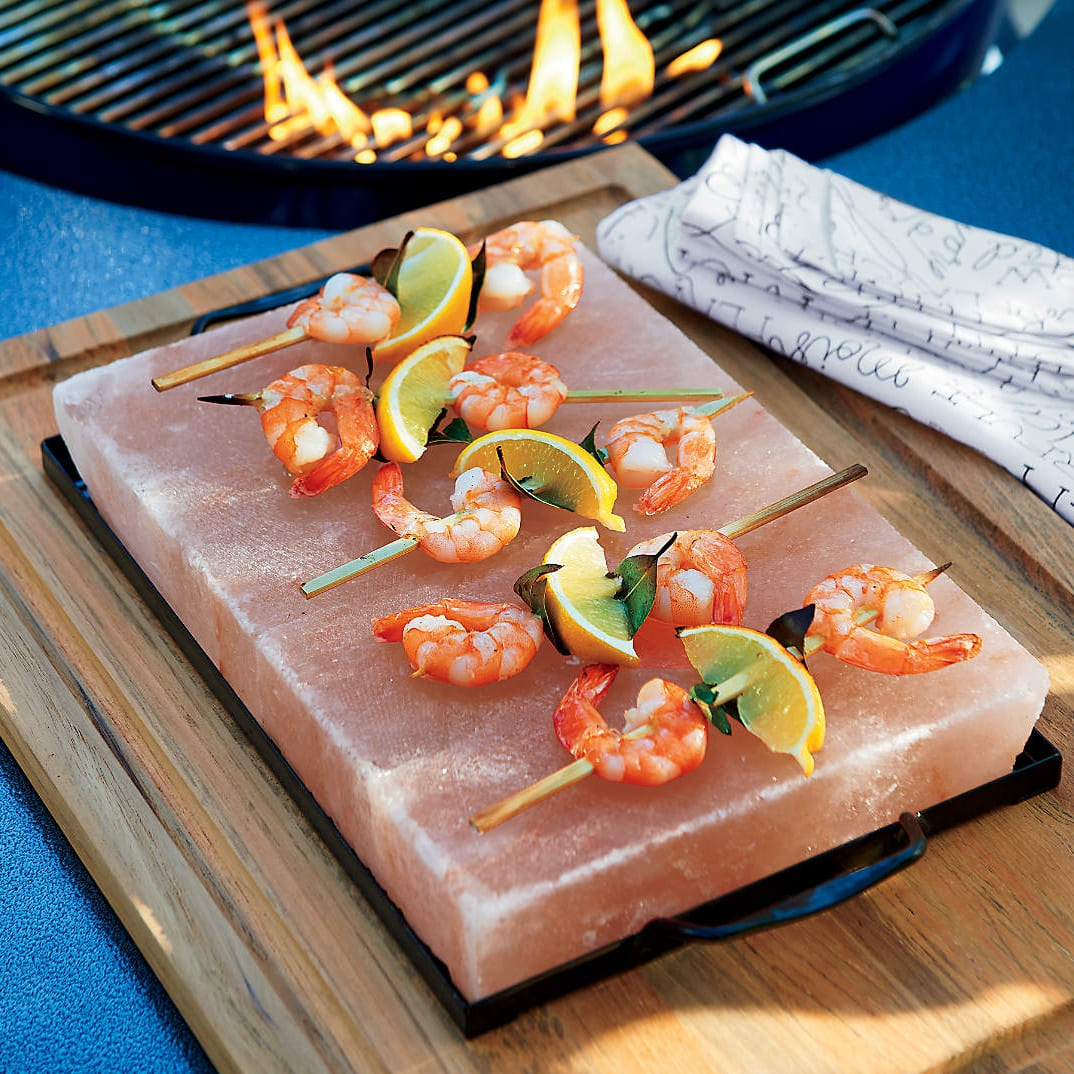Cooking on a Himalayan salt block introduces food to a delicate, mineral-rich depth of flavor unique to natural salt crystals. For culinary professionals, this method enhances texture, presentation, and taste, adding both refinement and complexity to simple dishes. The right beverage amplifies these effects—balancing salinity, lifting umami, and refreshing the palate. This guide breaks down five distinct drink pairings, revealing how each style—from sparkling wine to wheat beer—complements salt block cuisine with precision and purpose.

5 Drinks and Salt Block Cooking: Core Differences at a Glance
Selecting the right beverage for salt block-cooked dishes enhances every component on the plate. Each drink offers a distinct contribution—some refresh the palate, others deepen savory complexity. The table below compares five popular choices in terms of flavor profile, pairing compatibility, and overall dining experience.
| Drink | Primary Flavor Profile | Best Food Pairings | Effect on Palate | Typical Serving |
|---|---|---|---|---|
| Dry Sparkling Wine / Champagne | High acidity, dry, effervescent | Seafood, appetizers, charcuterie | Cleanses palate, enhances umami | Flute or coupe glass |
| Citrus-Driven Cocktails (Margarita, Gin & Tonic) | Bright citrus, botanical notes, tangy | Grilled seafood, vegetables, light meats | Balances salinity, refreshes palate | Rocks or highball glass with garnish |
| Wheat Beer (Hefeweizen, Belgian Wit) | Light, citrusy, subtly spiced | Shellfish, grilled chicken, lighter proteins | Cooling, smooth, offsets saltiness | Pint or weizen glass |
| Crisp White Wines (Sauvignon Blanc, Vermentino) | Herbal, aromatic, crisp acidity | Fish, poultry, grilled vegetables | Preserves delicacy, brightens flavors | White wine glass, well chilled |
| Aged Tawny Port / Light Sherry | Nutty, gently sweet, rich | Fruits, desserts, cheeses | Balances salt with layered sweetness | Small dessert glass |
What Makes Dry Sparkling Wines Ideal for Salt Block Cooking?
Dry sparkling wines—especially Champagne and Brut styles—offer bright acidity and refined effervescence that complement salt block-cooked dishes beautifully. Their crisp profile cuts through the richness of seafood or appetizers prepared on Himalayan salt, refreshing the palate between bites. This equilibrium allows the food’s delicate mineral notes to shine without interference from excess sweetness or weight.
These wines excel because their bubbles heighten both aroma and texture. Each sip cleanses the palate, enhancing the subtle umami and salinity imparted by the salt block. Opt for bottles labeled “Brut” or “Extra Brut” for the purest flavor expression. Served well-chilled in a flute or coupe glass, they maintain finesse and accentuate the elegant, savory finish that defines this pairing.

Key Characteristics of Dry Sparkling Wines
Dry sparkling wines are distinguished by high acidity, crisp structure, and restrained sweetness. Their fine mousse—those tiny, lingering bubbles—adds lift and vibrancy, enlivening delicate dishes cooked on Himalayan salt. This clarity of texture underscores precision in both taste and mouthfeel.
The dryness aligns seamlessly with the gentle salinity and umami of salt block seafood and appetizers. By keeping flavors focused and refreshing, these wines leave the palate clean and receptive, making them one of the most versatile companions for salt-enhanced cuisine.

Citrus-Driven Cocktails and Salt Block Cooking: A Refreshing Balance
How Citrus Cocktails Enhance Salt-Infused Dishes
Citrus-driven cocktails bring lively brightness that naturally offsets the salinity of foods cooked on Himalayan salt blocks. Drinks like margaritas or gin and tonics rely on fresh lime, lemon, or grapefruit to cut through the savory depth and umami layers formed during salt block cooking, keeping each flavor distinct and vibrant.
The botanical complexity of gin and the earthy sweetness of tequila harmonize with seafood, chicken, and grilled vegetables prepared on salt. Each spirit enhances the dish’s natural savoriness without dominating it. The result is a balanced interplay of freshness and mineral richness.
Because their acidity resets the palate between bites, citrus-based cocktails keep the dining experience crisp and engaging from start to finish. Their cleansing quality makes them some of the most effective and versatile pairing options for salt block cuisine.
Premium Himalayan Salt Blocks for Culinary & Hospitality
Partner with Jilin Ever Creation for fully natural, food-grade Himalayan salt products sourced from the Khewra Salt Mine. Perfect for grilling, serving, or retail display, our customizable salt blocks and accessories meet global safety standards and elevate your brand experience worldwide.

Wheat Beer vs. Crisp White Wine: Playful Contrasts for Salt Block Meals
Choosing between wheat beer and crisp white wine for salt block-cooked dishes depends on whether you want rounded freshness or clean lift. Both add balance and brightness to salt-enhanced meals, yet each creates a distinct texture and tempo on the palate. Wheat beers bring gentle spice and subtle creaminess, while crisp white wines cut through salinity with focused acidity. Here’s how to decide which pairing best complements your dish.
Wheat Beer’s Subtle Spice and Smooth Texture
Wheat beers such as Hefeweizen or Belgian Wit deliver soft citrus notes and understated spice that reflect the natural seasoning imparted by Himalayan salt. Their smooth body keeps seafood or chicken tender and flavorful without adding weight, while carbonation preserves a refreshing finish.
This approachable style suits relaxed meals that favor ease over intensity. Its mild sweetness and restrained bitterness round off savory notes, making salt block dishes taste cleaner and more balanced. Wheat beer encourages an unhurried pace, highlighting the food’s natural depth and texture.
Crisp White Wine’s Herbal Precision
White wines such as Sauvignon Blanc and Vermentino offer a sharper counterpoint. Their herbal bouquet and vivid acidity lift ingredients like vegetables, fish, and poultry prepared on a salt block, cutting through richness to reveal layered flavors that might otherwise stay hidden.
Served chilled, these wines feel taut and energetic. Their mineral backbone harmonizes with the salt’s own subtle complexity, creating a focused interplay that enhances delicate textures. When precision and clarity of flavor are your goals, crisp white wine provides a refined, expressive finish.
Sweet Fortified Wines with Salt Block Desserts: A Refined Finish
When a meal concludes with fruit or cheese prepared on a Himalayan salt block, the natural salinity can either highlight or overshadow sweetness, depending on the pairing. Fortified wines such as tawny port or light sherry complete the experience with warmth and harmony. Their layered richness enhances the caramelized notes developed during salt block cooking while maintaining balance and clarity on the palate.
Benefits of Pairing Aged Tawny Port and Light Sherry
Aged tawny port and lighter sherries offer nutty, caramel-infused tones that complement grilled fruits, figs, and soft cheeses. Their maturation deepens flavor complexity without adding weight, echoing the subtle umami introduced by the salt block. The measured sweetness smooths salinity, transforming potential contrast into an integrated, multi-dimensional profile.
Served slightly chilled, these wines remain engaging from first sip to last—sweetness adds depth, acidity keeps the palate refreshed, and the interplay of sweet, savory, and salt delivers an elegant close. This balance defines a polished finale for any salt block–cooked dessert.
The Final Verdict: Choosing the Right Drink for Salt Block Cooking
Selecting the right beverage for salt block-cooked dishes depends on how you want to balance the food’s natural salinity and umami depth. The ideal pairing enhances, rather than competes with, those flavors—from delicate seafood to rich desserts. Each drink type introduces a distinct counterpart—acidity, effervescence, spice, or sweetness—that helps achieve harmony on the palate.
For seafood or light starters, dry sparkling wine offers a refreshing lift that counterbalances salt and highlights texture. Those seeking lively, aromatic pairings can opt for citrus-driven cocktails such as a gin and tonic or margarita—their acidity and botanicals cut cleanly through grilled or savory dishes. Wheat beer provides a smooth, subtly spiced contrast suited to shellfish and lean proteins.
Crisp white wines like Sauvignon Blanc or Vermentino lend herbal notes and vibrant acidity that align beautifully with poultry and vegetables. To finish, aged tawny port or chilled sherry adds a sweet, nutty balance that flatters fruits and cheeses. Think of pairing as a conversation—each drink interacts with the dish to elevate its flavor, refresh the palate, or create a satisfying close.
Frequently Asked Questions About the Best Drinks for Salt Block Cooking
What is the best wine to serve with salt block steak?
A full-bodied red such as Cabernet Sauvignon or Syrah pairs exceptionally well with salt block steak. Their structure and depth complement the savory richness imparted by the salt. For those who prefer white wine, a well-chilled Vermentino provides balance through bright acidity and a clean finish.
Should I choose a salty or sweet drink to pair with salt block food?
Choose drinks that refresh the palate rather than echo the saltiness. Beverages with crisp acidity or gentle sweetness—such as dry sparkling wine or sherry—create contrast and maintain balance. The goal is to enhance the salt’s character without competing with it.
Are there non-alcoholic drinks that pair well with salt block-cooked meals?
Yes. Sparkling water infused with citrus or a well-balanced mocktail made with lime, cucumber, and herbs complements richness in the same way as a cocktail. Unsweetened iced tea or kombucha also pairs effectively thanks to their natural acidity and subtle effervescence.
Does a margarita taste better with a salt block–seared lime?
Yes. Lightly searing lime wedges on a salt block intensifies both aroma and flavor. The mild caramelization enriches the citrus profile, giving the margarita a warmer, more nuanced balance that complements its salted rim.
What kind of beer pairs best with grilled chicken from a salt block?
A wheat beer such as Hefeweizen or Belgian Wit is ideal. Its light body, citrus undertones, and gentle spice complement the smoky salinity of grilled chicken without dominating its flavor. Serve it well chilled to highlight its refreshing contrast.
Final Thoughts
A thoughtfully chosen drink transforms salt block cooking from an intriguing technique into a cohesive culinary experience. Each option—whether a crisp Sauvignon Blanc, a bright margarita, or a smooth wheat beer—balances the salt’s natural minerality and deep umami, enhancing rather than competing with the food.
Exploring these pairings allows you to align flavor, mood, and meal with precision. From citrus-led cocktails to refined wines, the right pour elevates every bite while maintaining balance on the palate.
Continue experimenting with how acidity, sweetness, and minerality interact with Himalayan salt. The point of harmony between salt block cuisine and intentional pairing is where true flavor refinement begins.






